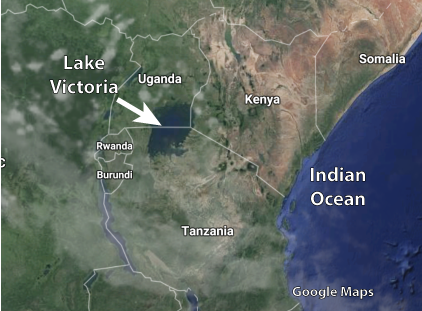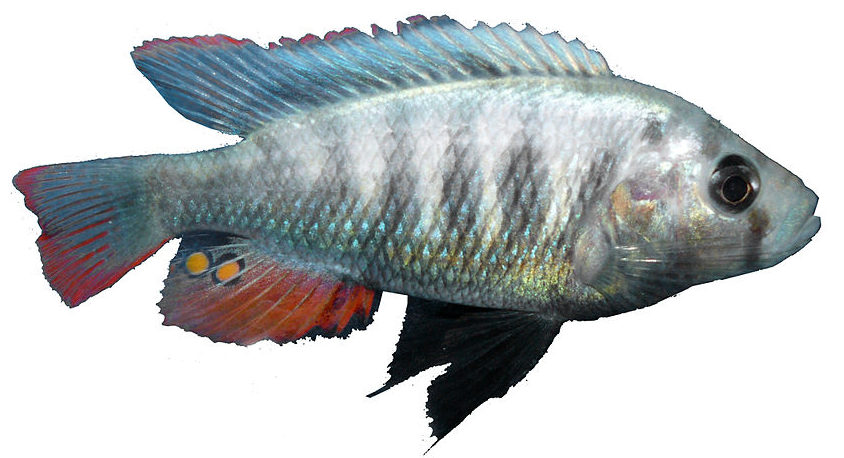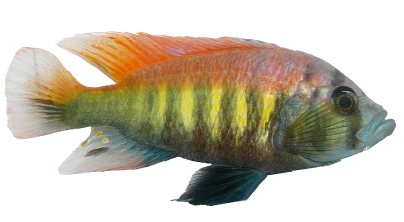1. Sympatric Speciation: Introduction
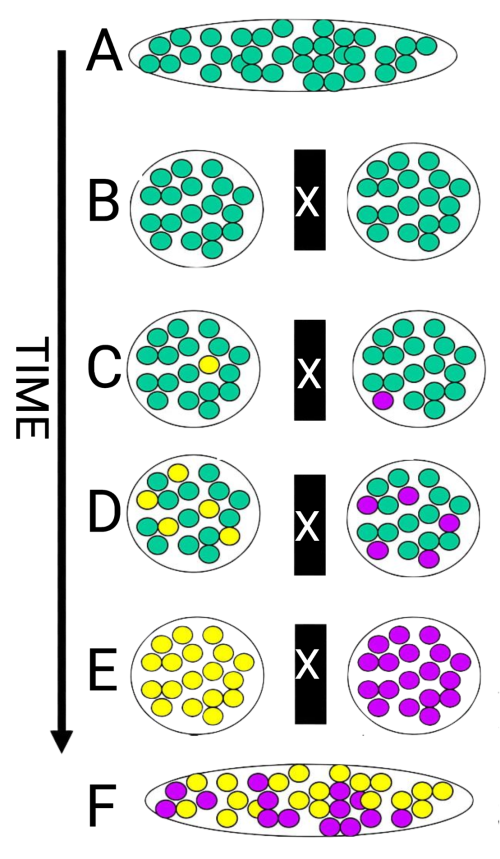
In the previous tutorial, you learned about allopatric speciation. Allopatric speciation involves a geographic barrier (“X” in the diagram at left) that splits a population into two. Once split apart, mutation and natural selection cause each subpopulation to differentiate. (shown at “C,” “D,” and “E”). Finally, the sub-populations become so different that when the barrier is removed (“F”), they become reproductively isolated: they can no longer interbreed. They’ve become two species.
In this tutorial, you’ll learn about a second type of speciation: sympatric speciation.
Start with the interactive reading below.
[qwiz qrecord_id=”sciencemusicvideosMeister1961-Sympatric Speciation: An Introduction (v2.0)”]
[h]Sympatric Speciation: An Introduction
[q labels = “right”]The diagram below contrasts allopatric speciation with sympatric speciation. You already know about allopatric speciation, so use what you know to label processes 1 and 2.
[l]allopatric
[fx] No. Please try again.
[f*] Good!
[l]sympatric
[fx] No. Please try again.
[f*] Excellent!
[q labels = “top”]_____________ speciation occurs without any ________________ barrier or separation. In other words,_______________ isolation between subgroups of a parent species has to arise while these subgroups are in the same geographical ________.
[l]area
[fx] No, that’s not correct. Please try again.
[f*] Excellent!
[l]geographical
[fx] No. Please try again.
[f*] Good!
[l]reproductive
[fx] No, that’s not correct. Please try again.
[f*] Good!
[l]sympatric
[fx] No. Please try again.
[f*] Excellent!
[q]The model below represents sympatric speciation. The key feature of this model is that the new species at “a” arises without any [hangman] barrier.
[c]Z2VvZ3Jh cGhpY2Fs[Qq]
[x]What’s the takeaway? Sympatric speciation happens without geographical barriers. Continue below to see how that can occur.
[/qwiz]
2. In plants, “instant” sympatric speciation can occur through changes in chromosome number
In plants and fungi (and less frequently in animals), sympatric speciation can arise through a process called polyploidy: a doubling (or more) of chromosome number. In agriculture, this process has been exploited by plant breeders in the development of several important crops.

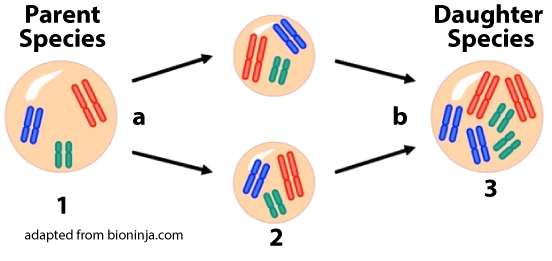
How does polyploidy come about? In what follows, we’re going to use some meiosis-related terms. If you need a review, click here.
In the diagram at right, the diploid number of an organism from the parent species is six (2n = 6, with three homologous pairs). An error during meiosis (represented by the arrow at “a”) creates gametes (2) that still have the diploid number of chromosomes, rather than a haploid set. If, as often happens in plants, these gametes self-fertilize (b), then a daughter species will be created with a diploid number of twelve (2n = 12, with six homologous pairs). If the parent and the daughter can’t hybridize (which could result from the fact that their chromosome numbers differ), then we have instant reproductive isolation and instant speciation.
A variation on polyploidy is allopolyploidy, where polyploidy is combined with hybridization, also resulting in instant speciation.
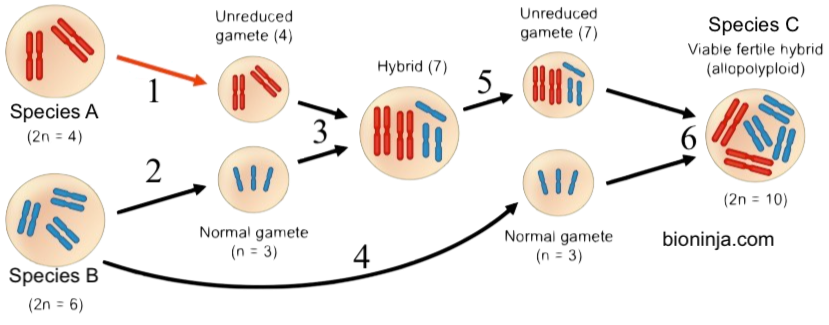
The diagram above shows how this might work. Species A (2n = 4) experiences an error in meiosis (represented by the arrow at 1), resulting in a diploid gamete. Species B produces a haploid gamete via normal meiosis (2). The gamete from species A fertilizes the gamete from species B (arrow at 3), producing a hybrid zygote with seven chromosomes. That hybrid undergoes abnormal meiosis (arrow at 5) producing a gamete that also has seven chromosomes. If that hybrid gamete gets fertilized (6) by a normal gamete from species B, then we have a new hybrid species (species C). Note that the new species has an even number of chromosomes (which is what a sexually reproducing species needs for successful meiosis).
If these sympatric speciation scenarios seem unlikely, consider this: between 30% and 80% of plant species are polyploid or allopolyploid descendants of previously existing species. This includes several varieties of domesticated plants, such as apples, bananas, wheat, cotton, potatoes, and sugar cane, as well as many non-domesticated species. (Wikipedia).
Based on the analysis of chromosome numbers, polyploidy is also a common speciation mechanism in fungi. It’s rarer in animals but does occur. For example, some fish species have up to 400 chromosomes, something that could have arisen through multiple duplications of chromosome sets.
3. Quiz: Sympatric Speciation through changes in chromosome number
[qwiz qrecord_id=”sciencemusicvideosMeister1961-Sympatric speciation through changes in chromosome number (v2.0)”] [h]
Sympatric speciation through changes in chromosome number
[i]
[q multiple_choice=”true”] Among the multicellular, eukaryotic kingdoms, speciation through chromosome number changes is least common in
[c]cGxhbnRz[Qq]
[f]Tm8uIFNwZWNpYXRpb24gdGhyb3VnaCBwb2x5cGxvaWR5IGFuZCBhbGxvcG9seXBsb2lkeSBpcyA=bW9zdA==IGNvbW1vbiBpbiBwbGFudHM=[Qq]
[c]IGFuaW 1hbHM=[Qq]
[f]WWVzISBTcGVjaWF0aW9uIHRocm91Z2ggcG9seXBsb2lkeSBhbmQgYWxsb3BvbHlwbG9pZHkgaXMgdW5jb21tb24gaW4gYW5pbWFscy4=[Qq]
[c]ZnVuZ2k=[Qq]
[f]Tm8uIFNwZWNpYXRpb24gdGhyb3VnaCBwb2x5cGxvaWR5IGFuZCBhbGxvcG9seXBsb2lkeSBpcyBmb3VuZCBpbiBmdW5naS4=[Qq]
[q] In the diagram below, which letter refers to (abnormal) meiosis?
[textentry single_char=”true”]
[c]IG E=[Qq]
[f]IE5pY2Ugam9iIQ==[Qq]
[c]IEVudGVyIHdvcmQ=[Qq]
[f]IE5vLg==[Qq]
[c]ICo=[Qq]
[f]IE5vLiBUaGlzIGRpYWdyYW0gaXMgYSBsaXR0bGUgY29uZnVzaW5nIHVubGVzcyB5b3Uga25vdyB0aGF0IGl0JiM4MjE3O3MgYWJvdXQgcG9seXBsb2lkeQ==LCBhIHByb2Nlc3MgdGhhdCBpbnZvbHZlcyBkb3VibGluZyBjaHJvbW9zb21lIG51bWJlci7CoCBJZiB0aGUgZ2FtZXRlcyBhcmUgYXQgJiM4MjIwOzIsJiM4MjIxOyB0aGVuIHdoaWNoIG51bWJlciBoYXMgdG8gcmVwcmVzZW50IG1laW9zaXM/[Qq]
[q] In the diagram below, which letter indicates fertilization?
[textentry single_char=”true”]
[c]IG I=[Qq]
[f]IEV4Y2VsbGVudCE=[Qq]
[c]IEVudGVyIHdvcmQ=[Qq]
[f]IE5vLCB0aGF0JiM4MjE3O3Mgbm90IGNvcnJlY3Qu[Qq]
[c]ICo=[Qq]
[f]IE5vLiBUaGlzIGRpYWdyYW0gaXMgYSBsaXR0bGUgY29uZnVzaW5nIHVubGVzcyB5b3Uga25vdyB0aGF0IGl0JiM4MjE3O3MgYWJvdXQgcG9seXBsb2lkeQ==LCBhIHByb2Nlc3MgdGhhdCBpbnZvbHZlcyBkb3VibGluZyBjaHJvbW9zb21lIG51bWJlci7CoCBJZiB0aGUgZ2FtZXRlcyBhcmUgYXQgJiM4MjIwOzIsJiM4MjIxOyB0aGVuIHdoaWNoIG51bWJlciBoYXMgdG8gcmVwcmVzZW50IGZlcnRpbGl6YXRpb24/[Qq]
[q] The diagram below represents speciation through a doubling in chromosome number. Multiplication of chromosome number is also known as [hangman].
[c]IHBvbHlwbG9pZHk=[Qq]
[f]IEdvb2Qh[Qq]
[q] Because it involves changes in chromosome number, polyploidy can result in [hangman] speciation,
[c]IGluc3RhbnQ=[Qq]
[f]IEdyZWF0IQ==[Qq]
[q] Polyploidy involves changes in [hangman] number.
[c]IGNocm9tb3NvbWU=[Qq]
[f]IEV4Y2VsbGVudCE=[Qq]
[q multiple_choice=”true”] The diagram below represents
[c]YWxsb3BvbH lwbG9pZHk=[Qq]
[f]IEV4Y2VsbGVudCEgVGhlIGRpYWdyYW0gYWJvdmUgc2hvd3MgYWxsb3BvbHlwbG9pZHk6IGFibm9ybWFsIG1laW9zaXMsIGZvbGxvd2VkIGJ5IGh5YnJpZGl6YXRpb24u[Qq]
[c]cG9seXBsb2lkeQ==[Qq]
[f]Tm8uIFBvbHlwbG9pZHkgaW52b2x2ZWQgc3BlY2lhdGlvbiB0aHJvdWdoIGEgZG91Ymxpbmcgb2YgY2hyb21vc29tZSBudW1iZXIuIEl0IGxvb2tzIGxpa2UgdGhpczo=
Cg==[Qq]
[q multiple_choice=”true”] Allopolyploidy starts with which of the following processes?
[c]IG1laW9zaXMgZm9sbG93ZWQgYnkgbWl0b3Npcw==[Qq]
[f]Tm8uIE1laW9zaXMgaXMgZGVmaW5pdGVseSBpbnZvbHZlZC4gQnV0IGl0JiM4MjE3O3MgZm9sbG93ZWQgYnkgYW5vdGhlciBzdGVwLiBXaGF0JiM4MjE3O3MgZ29pbmcgb24gaW4gbGluZXMgJiM4MjIwOzMmIzgyMjE7IGFuZCAmIzgyMjA7ND8mIzgyMjE7[Qq]
[c]Y2hyb21vc29tZSBkdXBsaWNhdGlvbiBmb2xsb3dlZCBieSBtZWlvc2lz[Qq]
[f]Tm8uIFBvbHlwbG9pZHkgaXMgZGVmaW5pdGVseSBpbnZvbHZlZC4gQW5kIChhYm5vcm1hbCkgbWVpb3NpcyBpcyBpbnZvbHZlZCwgdG9vLiBCdXQgdGhlcmUmIzgyMTc7cyBhbm90aGVyIGltcG9ydGFudCBzdGVwLiBXaGF0JiM4MjE3O3MgZ29pbmcgb24gaW4gbGluZXMgJiM4MjIwOzMmIzgyMjE7IGFuZCAmIzgyMjA7ND8mIzgyMjE7[Qq]
[c]Y2hyb21vc29tZSBkdXBsaWNhdGlvbiBm b2xsb3dlZCBieSBoeWJyaWRpemF0aW9u[Qq]
[f]Q29ycmVjdC4gRm9yIGFsbG9wb2x5cGxvaWR5LCB5b3UgbmVlZCBwb2x5cGxvaWR5LCBmb2xsb3dlZCBieSBoeWJyaWRpemF0aW9uIChmb2xsb3dlZCBieSBtb3JlIG1laW9zaXMgYW5kIGh5YnJpZGl6YXRpb24pLg==[Qq]
[q multiple_choice=”true”] In the diagram below, which number represents abnormal meiosis?
[c]ID Eg[Qq][c]IDIg[Qq][c]IDMg[Qq][c]IDQ=
Cg==[Qq][f]IEV4Y2VsbGVudC4gJiM4MjIwOzEmIzgyMjE7IHNob3dzIG1laW9zaXMgdGhhdCYjODIxNztzIG5vdCByZWR1Y2luZyBjaHJvbW9zb21lcyBudW1iZXIgZnJvbSBkaXBsb2lkIHRvIGhhcGxvaWQu[Qq]
[f]IE5vLiAmIzgyMjA7MiYjODIyMTsgc2hvd3Mgbm9ybWFsIG1laW9zaXMsIHdoZXJlIGNocm9tb3NvbWUgbnVtYmVyIGlzIHJlZHVjZWQgZnJvbSBoYXBsb2lkIHRvIGRpcGxvaWQuIEZpbmQgbWVpb3NpcyB3aGVyZSB0aGF0JiM4MjE3O3Mgbm90IGhhcHBlbmluZywgYW5kIHlvdSYjODIxNztsbCBoYXZlIHlvdXIgYW5zd2VyLg==[Qq]
[f]IE5vLiAmIzgyMjA7MyYjODIyMTsgaXMgc2hvd2luZyBmZXJ0aWxpemF0aW9uLiBGaW5kIGFuIGFycm93IHRoYXQgcmVwcmVzZW50cyBtZWlvc2lzLCBhbmQgeW91JiM4MjE3O2xsIGJlIG9uIHRoZSByaWdodCB0cmFjay4=[Qq]
[f]IE5vLiAmIzgyMjA7NCYjODIyMTsgaXMgc2hvd2luZyBub3JtYWwgbWVpb3Npcywgd2l0aCBjaHJvbW9zb21lIG51bWJlciBnb2luZyBmcm9tIGhhcGxvaWQgdG8gZGlwbG9pZC4gRmluZCBtZWlvc2lzIHdoZXJlIHRoYXQmIzgyMTc7cyBub3QgaGFwcGVuaW5nLCBhbmQgeW91JiM4MjE3O2xsIGhhdmUgeW91ciBhbnN3ZXIu[Qq]
[q multiple_choice=”true”] In the diagram below, which number represents fertilization?
[c]IDEg[Qq][c]IDIg[Qq][c]IDUg[Qq][c]ID Y=
Cg==[Qq][f]IE5vLiAmIzgyMjA7MSYjODIyMTsgcmVwcmVzZW50cyBhYm5vcm1hbCBtZWlvc2lzIChpbiB3aGljaCBjaHJvbW9zb21lIG51bWJlciBpcyBub3QgYmVpbmcgcmVkdWNlZCBmcm9tIGRpcGxvaWQgdG8gaGFwbG9pZC4gRmluZCBhIG51bWJlciB0aGF0IHJlcHJlc2VudHMgZ2FtZXRlcyBjb21pbmcgdG9nZXRoZXIu[Qq]
[f]IE5vLiAmIzgyMjA7MiYjODIyMTsgc2hvd3Mgbm9ybWFsIG1laW9zaXMuIEZpbmQgYSBudW1iZXIgdGhhdCByZXByZXNlbnRzIGdhbWV0ZXMgZnVzaW5nIHRvZ2V0aGVyLg==[Qq]
[f]IE5vLiAmIzgyMjA7NSYjODIyMTsgaXMgc2hvd2luZyBhYm5vcm1hbCBtZWlvc2lzLCBpbiB3aGljaCBjaHJvbW9zb21lIG51bWJlciBpcyBub3QgYmVpbmcgcmVkdWNlZC4gRmluZCBhIG51bWJlciB3aGVyZSBnYW1ldGVzIGFyZSBmdXNpbmcgdG9nZXRoZXIu[Qq]
[f]IEZhYnVsb3VzLiAmIzgyMjA7NiYjODIyMTsgaXMgc2hvd2luZyBmZXJ0aWxpemF0aW9uICh0aGUgb25lIHRoYXQgY3JlYXRlcyB0aGUgbmV3LCBhbGxvcG9seXBsb2lkIHNwZWNpZXMuKQ==[Qq]
[/qwiz]
4. Sympatric speciation in animals can occur through sexual selection
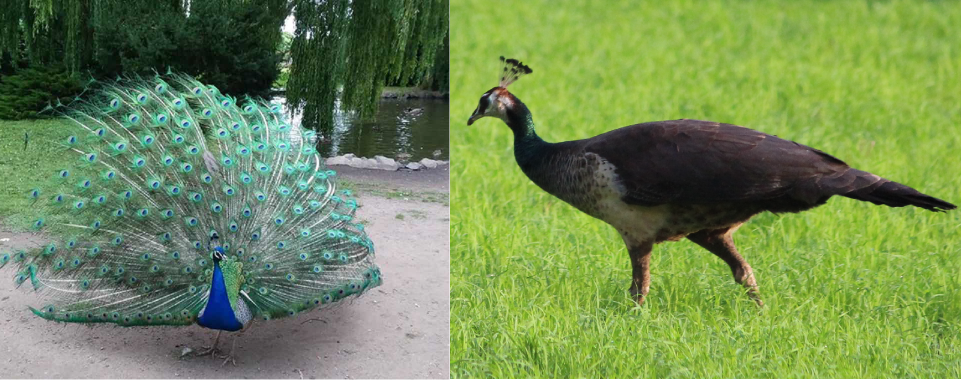
In animals, another way that sympatric speciation can occur is through intersexual selection. In this type of sexual selection, females choose their mating partners. The result is selection for a specific trait in males. If you want a spectacular example, think of the tail feathers of a peacock.
How could sexual selection lead to sympatric speciation? Consider the following scenario.
- Even without geographic barriers, the individuals of a species are organized into subgroups. We’ll use a flock of birds as an example, but it could also be a school of fish, a pack of dogs, etc.
- Within each flock, females develop a preference for a specific male trait. That preference could arise randomly, or it could be linked to some aspect of the environment.
- Because of that female preference, males with that trait wind up reproducing more. As a result, the alleles that code for that trait increase in the flock’s gene pool.
- At the same time, the alleles that code for the females’ preference for that trait are also passed on, and also increase in frequency.
- At a certain point, if that flock of birds mixes with another flock, then the females in the first flock won’t be interested in mating with the males from the second flock.
The key idea here is that female mate choice can lead to reproductive isolation. This reproductive isolation, if maintained for a long enough period, could lead to sympatric speciation.
Is there any evidence for this? Reproductive isolation by female mating preference seems to be what has powered a spectacular example of sympatric speciation in a type of fish called a cichlid (pronounced “sick-lid”).
|
|
|
|
Cichlids are found in tropical and subtropical waters throughout the world. Two male cichlids are shown above. Hundreds of cichlid species are found in Africa’s Lake Victoria, the world’s second-largest freshwater lake (second only to North America’s Lake Superior). While there are different types of habitats within the lake (deeper water, shallower water, sandbars, papyrus reeds, etc.) the lake has no internal barriers. In other words, allopatric speciation isn’t possible.
Many of the species in the lake have similar phenotypes. They might differ only by color markings (as shown above). Under laboratory conditions (as we’ll see below), fish from closely related species can hybridize (interbreed) and produce fertile, healthy offspring. Could female mate choice be what’s keeping these different species apart?
Here are a few things to consider.
1. In terms of color, there’s a lot of difference between male and female cichlids. The difference fits the intersexual selection pattern, with males having more ornamentation than females.
| Male P. nyererei | Female P. nyererei |
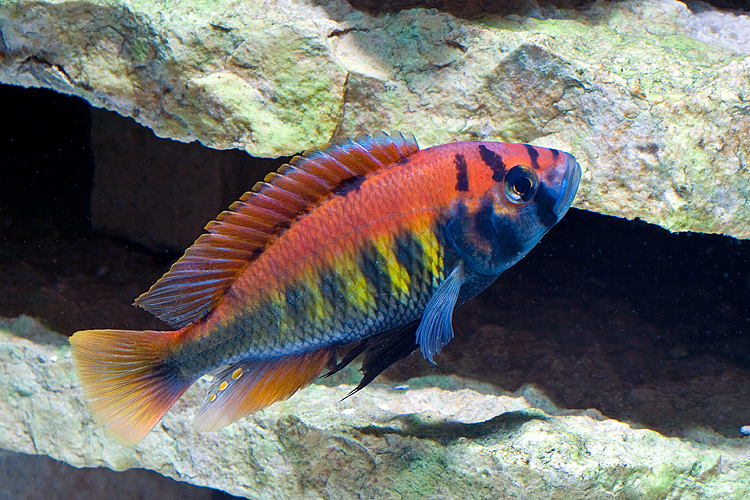 |
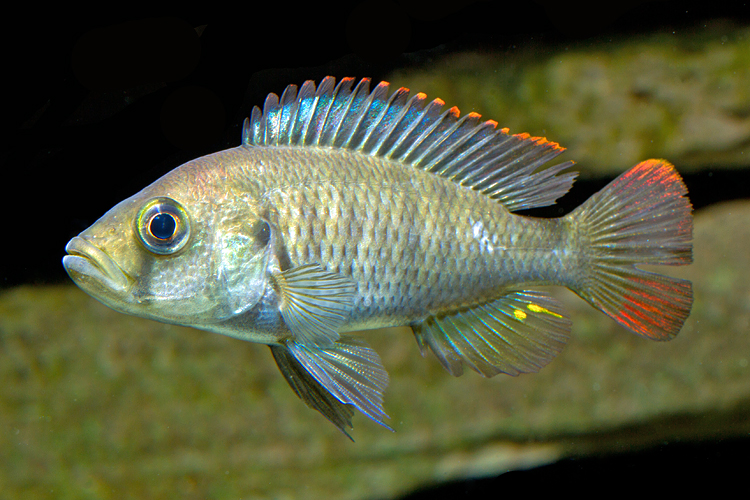 |
2. Female cichlids only lay eggs after being courted by males. In other words, the females get to choose whom they mate with.
3. When females can’t easily see the color markings on males, they seem to lose their preference for mating with males of their own species and mate just as frequently with males from closely related species.
When would this happen? In nature, it happens in areas where water is murky. And it can also be simulated in a laboratory.
Researchers O. Seehausen and J.J. M. van Alphen set up aquaria where males of P. pundamilia (which are blue) and P. nyererei (which are red) could be illuminated under normal white light (as shown on the left) or in orange light (as shown on the right). The diagram below shows what the fish would look like under each type of light. Note how hard it is to distinguish between the two species under orange light (right side).
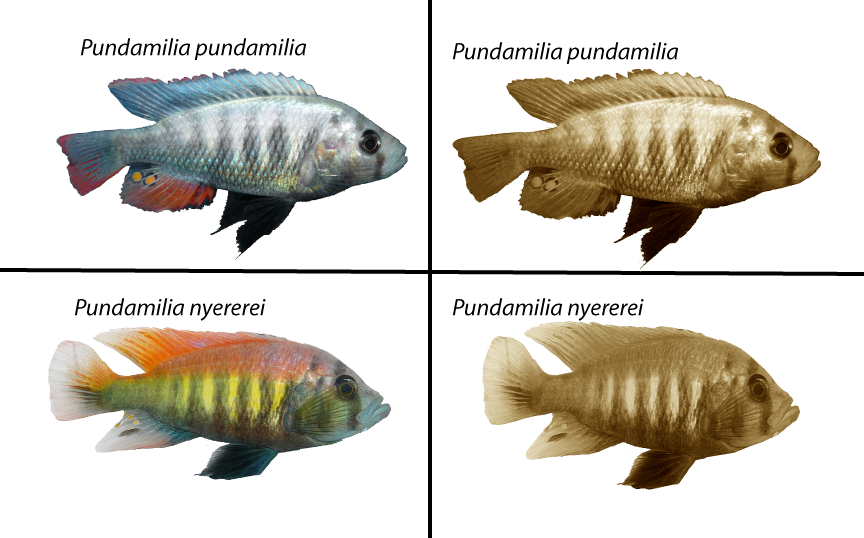
Next, females of each species were able to interact with the males under each type of light. To do this, the researchers created what’s called a “choice chamber.” It was set up as shown below. The males were trapped within a transparent enclosure that allowed them to attract the attention of a female that was placed in the middle of the tank.
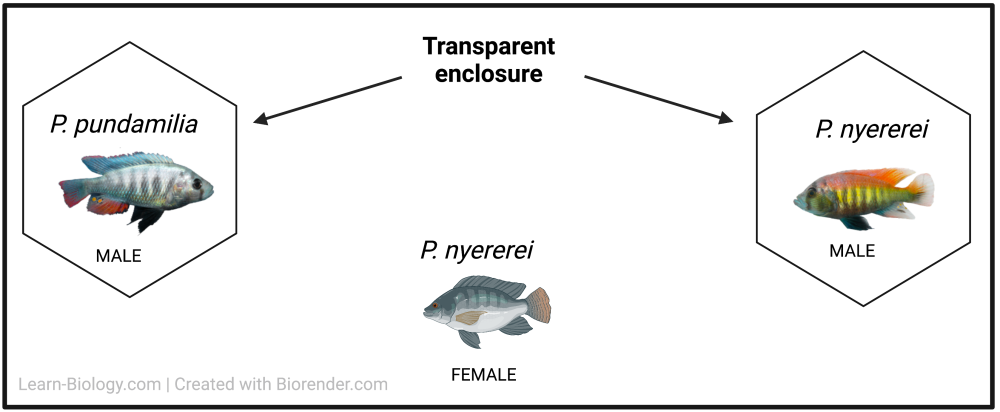
Guess what happened? Under normal (white) light, as shown above, the females had a clear preference for interacting with males of their own species.
Under orange light, as shown below, the results were different. The females interacted equally with the males of each species.
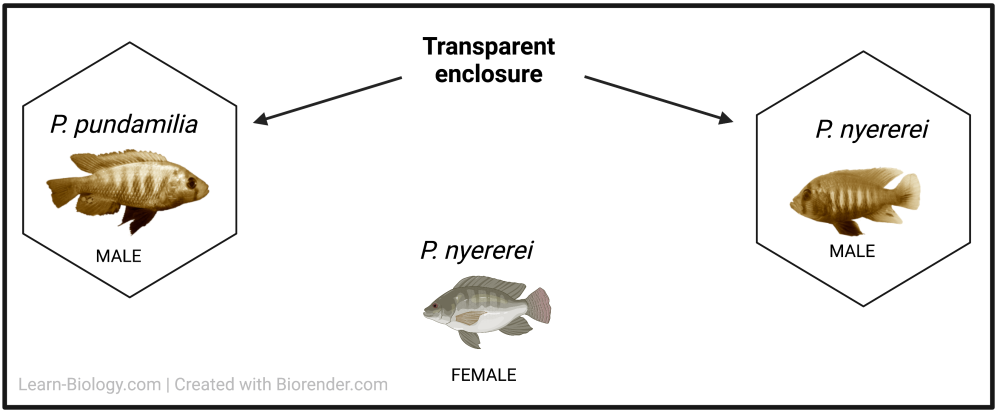
In other words, if the cue (color) that females used to choose their mates was taken away, the reproductive barrier between the two species would collapse. While this experiment doesn’t prove that female mate choice created the reproductive barrier between these two closely related species, it does suggest that it maintains this barrier.
5. Quiz: Sexual Selection and Sympatric Speciation
To consolidate what you’ve learned, answer the questions below.
[qwiz qrecord_id=”sciencemusicvideosMeister1961-Sexual selection and sympatric speciation (v2.0)”]
[h]Sexual selection and sympatric speciation
[q]Take a moment to examine the image below. All of the fish shown below are males. The left side shows how males of two species appear in cloudy water. The right side shows how they appear in clear water.
If female mate choice is at work, where do you expect there’d be more breeding between species (hybridization)?
[c]RW52aXJvbm1lbnQgMSAo Y2xvdWR5IHdhdGVyKQ==[Qq]
[c]RW52aXJvbm1lbnQgMiAoY2xlYXIgd2F0ZXIp[Qq]
[f]RXhjZWxsZW50LiBDbG91ZHkgd2F0ZXIgbWFrZXMgaXQgbW9yZSBkaWZmaWN1bHQgdG8gZGlzdGluZ3Vpc2ggYmV0d2VlbiB0aGUgYmx1ZXIgUC4gcHVuZGFtaWxpYcKgYW5kIHRoZSByZWRkZXIgUC4gbnllcmVyZWkuwqA=QXMgYSByZXN1bHQsIGZlbWFsZXMgY2FuJiM4MjE3O3QgZWFzaWx5IGNob29zZSBtYWxlcyBvZiB0aGVpciBvd24gc3BlY2llcywgYW5kIG1vcmUgaW50ZXJicmVlZGluZyAoaHlicmlkaXphdGlvbikgb2NjdXJzLg==[Qq]
[f]Tm8uwqBDbG91ZHkgd2F0ZXIgbWFrZXMgaXQgbW9yZSBkaWZmaWN1bHQgdG8gZGlzdGluZ3Vpc2ggYmV0d2VlbiB0aGUgYmx1ZXIgUC4gcHVuZGFtaWxpYcKgYW5kIHRoZSByZWRkZXIgUC4gbnllcmVyZWkuwqA=QXMgYSByZXN1bHQsIGZlbWFsZXMgY2FuJiM4MjE3O3QgZWFzaWx5IGNob29zZSBtYWxlcyBvZiB0aGVpciBvd24gc3BlY2llcywgYW5kIG1vcmUgaW50ZXJicmVlZGluZyAoaHlicmlkaXphdGlvbikgb2NjdXJzLg==[Qq]
[q]When females assess a male’s attractiveness as a way of choosing whom they’ll mate with, it’s known as [hangman] selection.
[c]aW50ZXJzZXh1YWw=[Qq]
[q multiple_choice=”true”]Intersexual selection can lead to
[c]bW9yZSBnZW5ldGljIGRpZmZlcmVudGlhdGlvbiBi ZXR3ZWVuIHN1Ymdyb3VwcyBvZiBhIHNwZWNpZXMu[Qq]
[f]RXhhY3RseS4gSW50ZXJzZXh1YWwgc2VsZWN0aW9uIGNhbiBsZWFkIGFsbGVsZXMgZm9yIGF0dHJhY3RpdmUgbWFsZSB0cmFpdHMgYW5kIGZlbWFsZSBwcmVmZXJlbmNlIGZvciB0aG9zZSB0cmFpdHMgdG8gaW5jcmVhc2Ugd2l0aGluIGEgc3VicG9wdWxhdGlvbi4gVGhhdCwgaW4gdHVybiwgY2FuIGluY3JlYXNlIGRpZmZlcmVuY2VzIGJldHdlZW4gc3VicG9wdWxhdGlvbnMgKGxpa2UgZmxvY2tzIG9mIGJpcmRzLCBzY2hvb2xzIG9mIGZpc2gsIGV0Yyku[Qq]
[c]bW9yZSBpbnRlcmJyZWVkaW5nIGFuZCBtaXhpbmcgYmV0d2VlbiBzdWJncm91cHMgb2YgYSBzcGVjaWVzLg==[Qq]
[f]Tm8uIEludGVyc2V4dWFsIHNlbGVjdGlvbiBjYW4gbGVhZCBhbGxlbGVzIGZvciBhdHRyYWN0aXZlIG1hbGUgdHJhaXRzIGFuZCBmZW1hbGUgcHJlZmVyZW5jZSBmb3IgdGhvc2UgdHJhaXRzIHRvIGluY3JlYXNlIHdpdGhpbiBhIHN1YnBvcHVsYXRpb24uwqAgV2hhdCBlZmZlY3Qgd291bGQgdGhhdCBoYXZlIG9uIGRpZmZlcmVuY2VzIGJldHdlZW4gc3VicG9wdWxhdGlvbnMgKGxpa2UgZmxvY2tzIG9mIGJpcmRzLCBzY2hvb2xzIG9mIGZpc2gsIGV0Yyk/[Qq]
[q] Female mate choice can lead to [hangman] isolation between populations. This can set the stage for [hangman] speciation.
[c]cmVwcm9kdWN0aXZl[Qq]
[c]c3ltcGF0cmlj[Qq]
[q labels =”top”]Based on what you’ve learned about cichlids, label the fish below.
[l]female
[fx] No, that’s not correct. Please try again.
[f*] Excellent!
[l]male
[fx] No. Please try again.
[f*] Great!
[q multiple_choice=”true”]When the experimental setup below was illuminated under normal light, P. nyererei cichlid females
[c]cmFuZG9tbHkgaW50ZXJhY3RlZCB3aXRoIG1hbGVzIG9mIHRoZWlyIG93biBzcGVjaWVzIG9yIGNsb3NlbHkgcmVsYXRlZCBzcGVjaWVzLg==[Qq]
[f]Tm8uIEZlbWFsZXMgb2YgdGhpcyBzcGVjaWVzIGFyZSBhdHRyYWN0ZWQgdG8gcmVkIG1hbGVzLiBXaGVuIHRoZXkgY2FuIHNlZSB0aGUgcmVkIGNvbG9yLCB3aGF0IHdvdWxkIHRoZXkgZG8/[Qq]
[c]c2hvd2VkIGEgY2xlYXIgcHJlZmVyZW5jZSBmb3IgaW50ZXJhY3 Rpbmcgd2l0aCBtYWxlcyBvZiB0aGVpciBvd24gc3BlY2llcy4=[Qq]
[f]RXhhY3RseS4gRmVtYWxlcyBvZiB0aGlzIHNwZWNpZXMgYXJlIGF0dHJhY3RlZCB0byByZWQgbWFsZXMu[Qq]
[c]YXZvaWRlZCB0aGVpciBvd24gc3BlY2llcywgY2hvb3NpbmcgaW5zdGVhZCB0byBpbnRlcmFjdCB3aXRoIG1hbGVzIG9mIGEgY2xvc2VseSByZWxhdGVkIHNwZWNpZXMu[Qq]
[f]Tm8uIEZlbWFsZXMgb2YgdGhpcyBzcGVjaWVzIGFyZSBhdHRyYWN0ZWQgdG8gcmVkIG1hbGVzLiBXaGVuIHRoZXkgY2FuIHNlZSB0aGUgcmVkIGNvbG9yLCB3aGF0IHdvdWxkIHRoZXkgZG8/[Qq]
[q multiple_choice=”true”]When the experimental setup below was illuminated under orange light, P. nyererei cichlid females
[c]cmFuZG9tbHkgaW50ZXJhY3RlZCB3aXRoIG1hbGVzIG9mIHRoZWlyIG 93biBzcGVjaWVzIG9yIGEgY2xvc2VseSByZWxhdGVkIHNwZWNpZXMgKFAuIHB1bmRhbWlsaWEp[Qq]
[f]RXhhY3RseS4gUC4gbnllcmVyZWk=IGZlbWFsZXMgYXJlIGF0dHJhY3RlZCB0byByZWQgbWFsZXMuIEJlY2F1c2UgdGhlIG9yYW5nZSBsaWdodCBtYWRlIGFsbCBtYWxlcyAocmVnYXJkbGVzcyBvZiBzcGVjaWVzKSBsb29rIHJlZCwgdGhlIGZlbWFsZXMgY291bGRuJiM4MjE3O3QgZGlzdGluZ3Vpc2ggdGhlIG1hbGVzIG9mIHRoZWlyIG93biBzcGVjaWVzIGFuZCBkaXNjcmltaW5hdGVkIGVxdWFsbHkgd2l0aCBtYWxlcyBvZiBlYWNoIHNwZWNpZXMu[Qq]
[c]c2hvd2VkIGEgY2xlYXIgcHJlZmVyZW5jZSBmb3IgaW50ZXJhY3Rpbmcgd2l0aCBtYWxlcyBvZiB0aGVpciBvd24gc3BlY2llcy4=[Qq]
[f]Tm8uIFdoaWxlIA==UC4gbnllcmVyZWk=IGZlbWFsZXMgbm9ybWFsbHkgcHJlZmVyIHRoZWlyIG93biByZWQtY29sb3JlZCBtYWxlcywgaW4gdGhpcyBleHBlcmltZW50YWwgc2V0dXAgdGhleSB3ZXJlIHVuYWJsZSB0byBkaXN0aW5ndWlzaCBtYWxlcyBvZiB0aGVpciBvd24gc3BlY2llcyBmcm9tIG90aGVyIG1hbGVzLiBXaGF0IHdvdWxkIGhhcHBlbj8=[Qq]
[c]YXZvaWRlZCB0aGVpciBvd24gc3BlY2llcywgY2hvb3NpbmcgaW5zdGVhZCB0byBpbnRlcmFjdCB3aXRoIG1hbGVzIG9mIGEgY2xvc2VseSByZWxhdGVkIHNwZWNpZXMu[Qq]
[f]Tm8uIFdoaWxlIA==UC4gbnllcmVyZWk=IGZlbWFsZXMgbm9ybWFsbHkgcHJlZmVyIHRoZWlyIG93biByZWQtY29sb3JlZCBtYWxlcywgaW4gdGhpcyBleHBlcmltZW50YWwgc2V0dXAgdGhleSB3ZXJlIHVuYWJsZSB0byBkaXN0aW5ndWlzaCBtYWxlcyBvZiB0aGVpciBvd24gc3BlY2llcyBmcm9tIG90aGVyIG1hbGVzLiBXaGF0IHdvdWxkIGhhcHBlbj8=[Qq]
[/qwiz]
Main source: Philosophical Transactions of The Royal Society B Biological Sciences 363(1505):2871-7 · June 2008
The cichlids of Lake Victoria are not the only experimentally confirmed example of sexual selection leading to speciation. The links below both lead to short videos on youtube.
- Click here for an example involving Anole Lizards in the Caribbean Islands.
- Click here for an example involving the Galapagos finches.
6. Sympatric Speciation through Habitat Differentiation
The last mechanism underlying sympatric speciation is habitat differentiation.
6a. Case study 1: Bird Lice
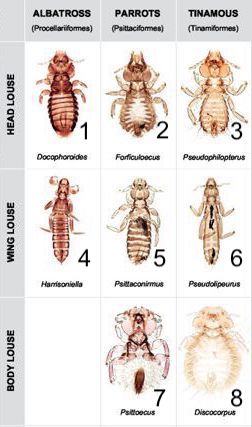
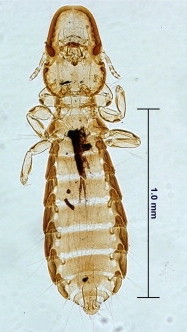
The table to the left shows eight different species of bird lice. Another species (which parasitizes the common buzzard) is shown at right.
Bird lice are parasitic insects that feed on bird feathers, scales, or blood. The 8 shown are a very small sample of a group that includes dozens of species.
Speciation in bird lice has two dimensions:
1) Different types of birds are parasitized by different species of lice (with some lice species parasitizing albatrosses, others parrots, etc.).
2) Different species of lice specialize in different parts of the birds. In other words, one species of louse is adapted for life on the head of albatrosses, and another species is adapted for life on albatrosses’ wings. Parrots (and other types of birds) similarly have their own uniquely adapted head, wing, and body lice.
How could such speciation arise?
Imagine the ancestors of today’s bird-lice, tens of millions of years ago. These parasites might have already parasitized the small dinosaurs that were the ancestors of birds. As ancestral birds differentiated into different species, each living in different habitats, nesting in different areas, and more or less common in different geographical areas, the lice on each species of bird would find their gene pools to be largely cut off from the bird lice that were parasitizing other bird species. Genetic drift and natural selection would cause the bird lice parasitizing these different bird species to genetically differentiate, evolving into separate species.
Note that while these emerging species were on different types of birds, there was never any geographical barrier (so we can’t think of this as allopatric speciation).
Now think about the lice on each bird. The bird lice that parasitized albatrosses spread over the albatross’s body, some living on the albatross’s heads, some on their wings, and so on. The adaptations required for hiding, feeding, and holding on to the head were different from the adaptations required for hiding, feeding, and holding on to the wings. So, on each bird, there’s disruptive selection. Over time, the albatross head lice become reproductively isolated from the albatross wing lice.
6b. Case Study 2: Apple Maggot Flies
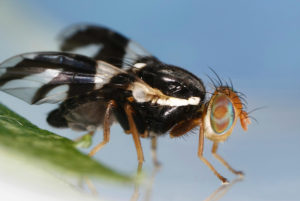
Another example of sympatric speciation through habitat differentiation has occurred within the last few hundred years. It has involved the apple maggot fly, Rhagoletis pomonella.
The apple maggot fly is native to North America. Its original host was the fruit of Hawthorn trees. Females lay their eggs on Hawthorn fruit. The eggs develop into maggots, which consume the fruit as they grow.

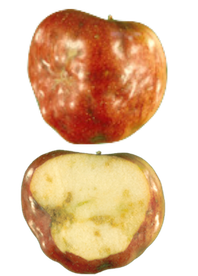
Apples and hawthorns are both in the same botanical family, Rosaceae. When European colonists introduced domesticated apples into North America in the 1600s, it didn’t take long for Rhagoletis to jump from its original host to the newly introduced apples. By the mid-1800s, Rhagoletis was causing crop losses in apple orchards, and it continues to be a major agricultural nuisance to this day.
Those Rhagoletis populations that parasitize apples seem to be heading down a road that will result in their forming a new species. At this point, though still one species, two identifiable variants have evolved: one with a preference for apples, the other with a preference for hawthornes
What keeps the two populations apart? For one thing, Rhagoletis flies lay their eggs on the same type of fruit where they themselves developed, which creates a habitat barrier, reducing gene flow between the hawthorn and apple populations. In addition, hawthorns and apples produce fruit at different times of the year, with apples producing fruit between July and August, and hawthorns producing fruit between September and October. This creates a temporal barrier between the two populations, further reducing gene flow.
In addition, a recent study has uncovered differences in smell preferences in each sub-group, with Hawthorn-infesting flies preferring the smell of hawthorns, and apple-infesting flies preferring the smell of apples. This provides a behavioral and neurological basis for further differentiation.
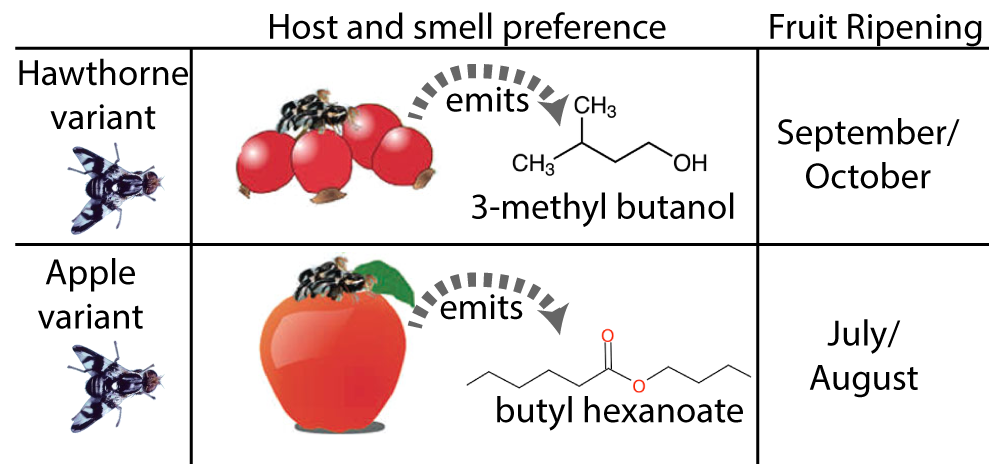
Click here to read a study about smell preferences, and here for a more general overview of Rhagoletis evolution.
7. Sympatric Speciation: Checking Understanding
In this tutorial, you’ve learned that speciation can occur sympatrically: without a geographic barrier. Test your mastery by answering the questions below.
[qwiz qrecord_id=”sciencemusicvideosMeister1961-Sympatric Speciation: Checking Understanding (v2.0)”]
[h]Sympatric Speciation: Checking Understanding
[i]
[q]As opposed to [hangman] speciation, which involves a geographical barrier, [hangman] speciation occurs without a geographic barrier.
[c]YWxsb3BhdHJpYw==[Qq]
[c]c3ltcGF0cmlj[Qq]
[q][hangman] is a process that involves the duplication of entire chromosome sets.
[c]cG9seXBsb2lkeQ==[Qq]
[q]Of the multicellular eukaryotic kingdoms, the one with the least amount of speciation through polyploidy is the ____________ kingdom.
[hangman]
[c]YW5pbWFs[Qq]
[q]The type of speciation represented below is [hangman].
[c]cG9seXBsb2lkeQ==[Qq]
[q]The diagram below shows the appearance of male cichlids in cloudy and clear water. The fact that more interbreeding (hybridization) occurs in environment 1 than in environment 2 seems to be evidence that [hangman] mate choice based on [hangman] selection is acting as a reproductive barrier between Cichlid species.
[c]ZmVtYWxl[Qq]
[c]aW50ZXJzZXh1YWw=[Qq]
[q]In any model of sympatric speciation, a key thing to explain is what’s preventing _______ flow between emerging species.
[hangman]
[c]Z2VuZQ==[Qq]
[q]Bird lice and apple maggot flies are both examples of sympatric speciation through [hangman] differentiation
[c]aGFiaXRhdA==[Qq]
[q]Rhagoletis flies infesting hawthorns have to breed later in the year than Rhagoletis flies infesting apples. This is an example of a __________ barrier.
[hangman]
[c]dGVtcG9yYWw=[Qq]
[q]_________ speciation occurs without a geographic barrier.
[hangman]
[c]c3ltcGF0cmlj[Qq]
[q]____________ is a process that involves the duplication of entire chromosome sets.
[hangman]
[c]cG9seXBsb2lkeQ==[Qq]
[q]____________ is a process that involves an increase in chromosome number combined with hybridization.
[hangman]
[c]YWxsb3BvbHlwbG9pZHk=[Qq]
[q]Of the multicellular eukaryotic kingdoms, the one with the least amount of speciation through polyploidy or allopolyploidy is the ____________ kingdom.
[hangman]
[c]YW5pbWFs[Qq]
[q]The type of speciation represented below is
[hangman]
[c]YWxsb3BvbHlwbG9pZHk=[Qq]
[q]As represented by the diagram below, the fact that more hybridization occurs in environment 1 than in environment 2 seems to be evidence for [hangman] selection acting as a reproductive barrier between Cichlid species.
[c]c2V4dWFs[Qq]
[q]The diagram below shows the effect of [hangman] selection.
[c]ZGlzcnVwdGl2ZQ==[Qq]
[q multiple_choice=”true”]Disruptive selection could lead to speciation by eliminating __________ genotypes (and phenotypes) within a population.
[c]aG9tb3p5Z291cw==[Qq]
[f]Tm8uIERpc3J1cHRpdmUgc2VsZWN0aW9uIGlzIHNlbGVjdGlvbiBhZ2FpbnN0IGludGVybWVkaWF0ZSBwaGVub3R5cGVzLiBIb21venlnb3VzIHBoZW5vdHlwZXMgd291bGRuJiM4MjE3O3QgYmUgaW50ZXJtZWRpYXRlLiBIaW50OiB3aGF0IHdvcmQgbWVhbnMgJiM4MjIwO2EgY29tYmluYXRpb24gb2YgYm90aD8mIzgyMjE7[Qq]
[c]aHli cmlk[Qq]
[f]TmljZS4gRGlzcnVwdGl2ZSBzZWxlY3Rpb24gd291bGQgc2VsZWN0IGFnYWluc3QgaW50ZXJtZWRpYXRlIHBoZW5vdHlwZXM=[Qq]
[c]ZG9taW5hbnQ=[Qq]
[f]Tm8uIFdoYXQgZ2V0cyBzZWxlY3RlZCBieSBuYXR1cmFsIHNlbGVjdGlvbiBpcyByZWxhdGVkIHRvIGhvdyB3ZWxsLWFkYXB0ZWQgYSBwaGVub3R5cGUgaXMuIFRoZXJlJiM4MjE3O3Mgbm8gY29ubmVjdGlvbiBiZXR3ZWVuIHRoYXQgYW5kIGFuIGFsbGVsZSBiZWluZyBkb21pbmFudCBvciByZWNlc3NpdmUu[Qq]
[c]cmVjZXNzaXZl[Qq]
[f]Tm8uIFdoYXQgZ2V0cyBzZWxlY3RlZCBieSBuYXR1cmFsIHNlbGVjdGlvbiBpcyByZWxhdGVkIHRvIGhvdyB3ZWxsLWFkYXB0ZWQgYSBwaGVub3R5cGUgaXMuIFRoZXJlJiM4MjE3O3Mgbm8gY29ubmVjdGlvbiBiZXR3ZWVuIHRoYXQgYW5kIGFuIGFsbGVsZSBiZWluZyBkb21pbmFudCBvciByZWNlc3NpdmUu[Qq]
[x]
[restart]
[/qwiz]
8. Adaptive Radiation Revisited
In a previous tutorial about homologous structures as evidence for evolution, we introduced the idea of adaptive radiation: one ancestral species splitting into multiple descendants. As a case study, we examined the finches of the Galapagos Islands. These birds comprise a group of 13 species (only a few of whom are shown in the images below). Each species is morphologically different, particularly in terms of the shape and size of its beak. Correspondingly, each species exploits a distinct ecological niche, with some birds adapted for eating large seeds, others small seeds, others insects, others cactus flowers, etc.
The image on the left below shows several of these species and their putative common ancestor. The image on the right shows these species arranged into an evolutionary tree
 |
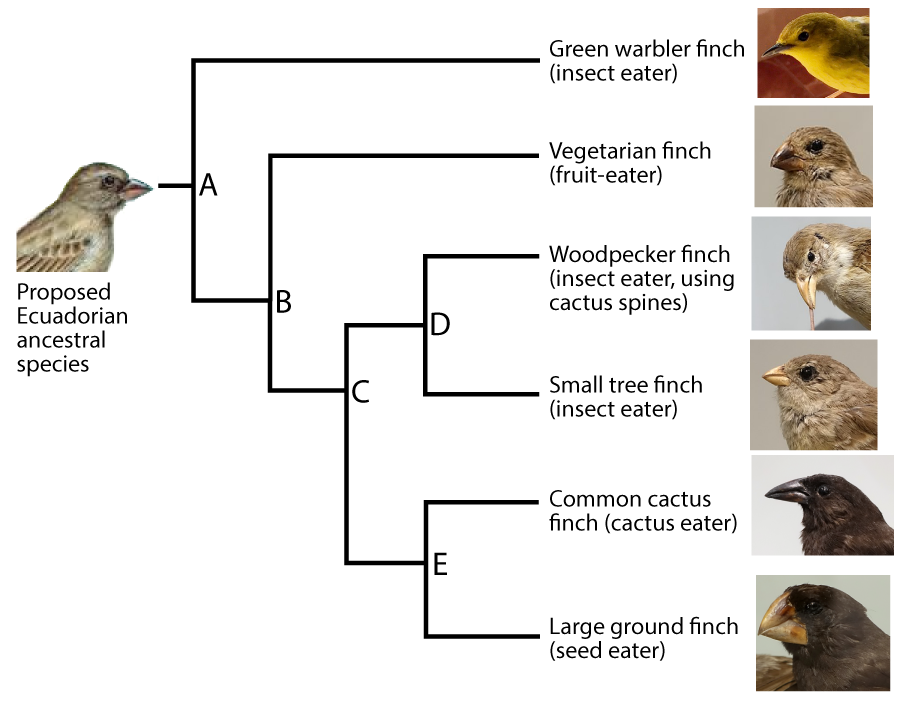 |
 How did the multiple speciation events that gave rise to this group of related species unfold? The idea is that a small population of ancestral finches, originally from what is now Ecuador, colonized the Galapagos islands a few million years ago. Because the islands are over 1000 kilometers from the South American mainland, the trip was probably an accidental one, with the original colonists being blown over in a storm. Over the thousands of generations that followed, allopatric and sympatric mechanisms led this ancestral species to split into the current array of species.
How did the multiple speciation events that gave rise to this group of related species unfold? The idea is that a small population of ancestral finches, originally from what is now Ecuador, colonized the Galapagos islands a few million years ago. Because the islands are over 1000 kilometers from the South American mainland, the trip was probably an accidental one, with the original colonists being blown over in a storm. Over the thousands of generations that followed, allopatric and sympatric mechanisms led this ancestral species to split into the current array of species.
Use the exercise below to see if you can tell the story of how the original ancestral species evolved into five descendants.
[qwiz summary=”false” style=”min-height: 450px !important; width: 600px !important;” qrecord_id=”sciencemusicvideosMeister1961-Adaptive Radiation in an Island Chain (v2.0)”]
[h] Adaptive Radiation in an Island Chain
[q]Study the diagram below. Roman numerals represent stages, Numbers are steps in the process. Letters “A” through “E” are evolving populations. Letters “w” through “z” are land masses.
See if you can tell the story of how the original ancestral species evolved into five descendants.
[q] In stage I, species A from the mainland (“w”) arrives at island “x.” In stage II, processes like genetic drift and natural selection have caused the island population of A to evolve into species B. Another migration (represented by 3) shows some members of species B moving onto island “y.”
[q] Stage III begins with species B evolving into species C (step 4). Some members of species C migrate to island “z” (step 5) and then some members of that population migrate back to island X (step 6). However, species C has become reproductively isolated from species B, and the two coexist on island “x.”
[q] In stage IV, the population of species C on island “y” evolves into species D (step 7). After that, some members of species D migrate to island “z” (where they coexist with species C), while others migrate back to island “x.” As a result, three species (B, C, and D) are coexisting on island “x.”
[q] In stage V, the different conditions on island “x” cause the individuals from species D to evolve into a new species, species E (step 9). Now island “x” has three species (B, C, E), island “y” has one species (D), and island Z has two species C and D. Species A continues to exist on the mainland, so where there was once one species, there are now five.
[x]Now, see if you can write out the entire story in your student learning guide. How did one species evolve into five?
[restart]
[/qwiz]
Adaptive radiation on island chains explains the incredible biodiversity that’s found on islands. According to UNESCO (United Nations Educational, Scientific and Cultural Organization),
Although islands account for just five percent of the world’s land mass, they are home to approximately seventeen percent of the world’s bird and plant species. Some tropical coastlines are home to coral reefs that are among the most biologically diverse ecosystems in the world – sustaining the livelihoods of millions of people. Many island species are found only on one island or island group and are thus considered endemic to that location.
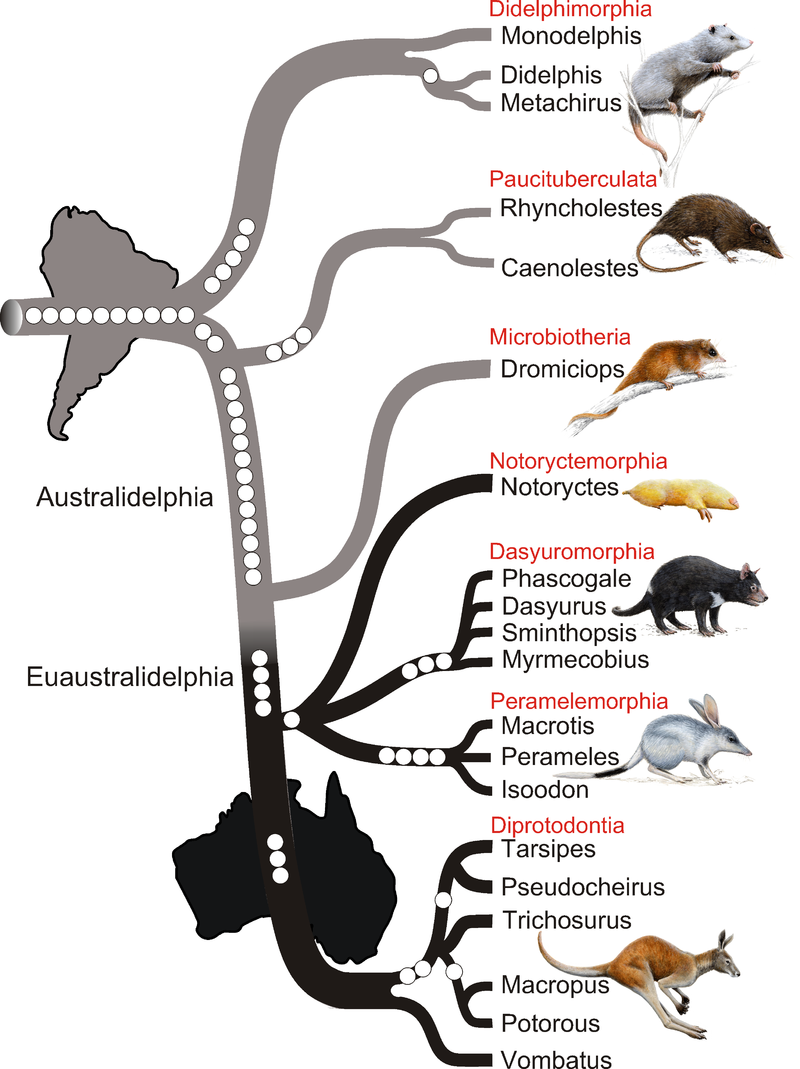
But while adaptive radiation is, perhaps, easiest to see on island chains, it’s not just an island-related phenomenon. Rather, adaptive radiation is the pattern by which life has spread and diversified over planet Earth, ever since the emergence of life on Earth almost 4 billion years ago. The image on the left shows the story of the adaptive radiation of marsupial mammals. While these pouched mammals are mostly associated with Australia, they emerged in South America as long as 100 million years ago (during the time of the dinosaurs). Over the subsequent years, marsupials diversified into a variety of orders, each of which consists of one or more families, genera, and species. Each branching of the tree, in other words, represents another instance of adaptive radiation.
The same is true of any group of related organisms. That’s a topic we’ll address in the next major topic in AP Bio Unit 7, where we look at how the branching evolutionary trees shown on the left and above are drawn. But before we address that, we’ll explore the various reasons why species become extinct.
What’s next?
Proceed to Topics 7.10 – 7.12, part 4, Extinction, the next topic in AP Bio Unit 7, Evolution.

